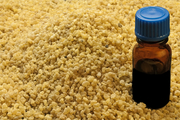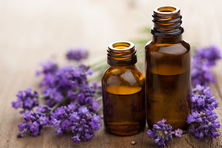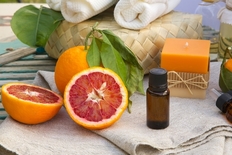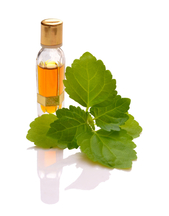|
Bone Construction & Growth:
Mostly made of Type II Collagen the bones in your body are living, constantly changing matter and cells. Bones require calcium for strength and maintain stores of calcium for use by other parts of the body. There are two different types of bone tissue that comprise the 206 bones found in the adult body. The first is the outer layer called cortical, or compact, bone that accounts for 80% of bone mass. It is dense, durable, and rigid, protecting the inner layer of bone from damage caused by external forces. Muscles and tendons are attached to a fibrous membrane called periosteum that covers cortical bone. Capillaries run through the periosteum to supply cortical bone with blood and nutrients. The inner layer of bones is called cancellous, or spongy, bone and is far less dense. Cancellous bone has a latticework of small chambers that contain connective tissue and bone marrow, where new red blood cells are produced. Cancellous bone provides structure and flexibility to the body with the ability to absorb shock inside the bone. Ossification is the process by which cartilage is transformed into new bone, beginning the third month of fetus life and is fully completed by late adolescence. Calcium and phosphate cells accumulate on cartilage cells, and once minerals surround these cells, they begin to die off and leave small pockets of separation. Small blood cells start to fill these spaces delivering osteoblasts, specialized cells collecting calcium and producing a substance filled with collagen fibers, called osteoid, to help build cortical bone. Osteoid is made stronger by minerals. Osteoblasts build bone by piling it up around themselves and become trapped inside turning into osteocytes. They are star shaped cells with long reaching arms that connect them to neighboring osteocytes from which they communicate and exchange nutrients. Some osteoblasts become lining cells that help control the movement of molecules in and out of bone. Your bones are constantly under reconstruction. Bones need repair from breaks, fractures, and damaged blood vessels, nerves and veins. The cells responsible for breaking down and reabsorbing existing bones are called osteoclasts. They often contain more than one nucleus and work with other osteoclasts as a team to reshape and rebuild bone. Bones that are used less often are broken down to support other calcium and bone needs in the body. Your bones are like muscles in that they grow, thicken, and build endurance when challenged and used consistently. You can make improvement in bone mineral density quickly with the right forms and amount of exercise. Doing full body, impact based exercise like running, jumping, and circuit training three times a week can significantly increase bone density in as little as 4-6 months. Exercise is also the greatest form of prevention for bone loss due to aging. You should consistently be increasing the resistance and intensity of your exercise training. Bone Loss: The U.S. Centers for Disease Control and Prevention reports that one in six Americans has osteoporosis or early signs of the disease (osteopenia), and that one in four senior women in the United States have osteoporosis. It is predicted that one quarter of men over the age of 50 will suffer an osteoporosis-related fracture. The bones most affected by osteoporosis are the hip, spine, and wrists. When you are young you have more osteoblast cells than osteoclast cells resulting in bone gain. As you age osteoblasts are unable to maintain the pace of osteoclasts that are still able to efficiently break down bone, leading to loss of bone mass. Other factors that contribute to bone loss include a sedentary lifestyle, smoking, malnutrition, drinking alcohol in excess, and low estrogen. Calcium: There are many types of calcium, hence the confusion in picking the right supplement to effectively strengthen and build your bones. You body absorbs calcium better when taken in small doses. Calcium also helps blood vessels regulate blood flow, assists in muscle contractions, supports nerve cell communication, and contributes to blood clotting. Your body also absorbs calcium better when taken in small doses. –Calcium Carbonate is the most common and cheapest form of calcium supplement available. It is found in rocks, limestone, shells of marine animals, coral, pearls, eggshells and snails. It is highly concentrated in elemental calcium but is not highly bioavailable, and has very poor solubility in water. Meaning, it is hard for your body to digest this type of calcium and utilize it for bone strength or any other health purpose. It also requires more stomach acid to be absorbed, and as you age your body produces less and less stomach acid. This further decreases its bioavailability and assumed potency. This is also the type of calcium that has been clinically shown to increase your risk for heart attacks and strokes because it leaves deposits in the arteries, increasing arterial plaque. It is about 40% calcium with an approximated bioavailability of 40%. –Calcium Citrate has an acidic base meaning it is more easily digested because is requires less stomach acid, but it is low in elemental calcium thus creating low bioavailability. It is about 20% calcium with an approximated bioavailability of 40%. –Oyster Shell Calcium, dolomite and bone mean are marketed as natural forms of highly absorbable calcium because they are mostly made from calcium carbonate. However they have all shown to have high toxic levels of lead. –Calcium Gluconate has very low levels of elemental calcium, about 9-15%. Large amounts would need to be taken to have an impact on bone health, and its bioavailability is unknown due to contradicting studies. –Calcium Lactate is found in food sources like aged cheese and baking powder. It is added to many fresh fruits to help maintain their firmness and extend shelf life. This form of calcium is what you find in antacids and has a medium bioavailability in the body. This is why you hear many doctors suggesting people take Tums for calcium supplementation! However it only contains 9-13% elemental calcium and is not a good choice for people who are lactose intolerant. –Calcium Phosphate is from cow’s milk, nuts and seeds, beans, broccoli, dark leafy greens, black-eyed peas, figs, oranges, tofu, and salmon or sardine. Tooth enamel and bones are made mostly of calcium phosphate. It contains 39% elemental calcium. However supplement forms of this type of calcium, found as tricalcium phosphate are not bioavailable. The best way to get this form of calcium is from whole food, organic sources. –Calcium Citrate Malate is a water-soluble form of calcium that is created when calcium salts found in citric acids are mixed with malic acid. It is has more bioavailability than any of the previously listed calcium’s, as high as 42%, however it only contains roughly 26% elemental calcium. –Calcium Hydroxyapatite and Microcrystalline Hydroxyapatite Complex (MCHC): Calcium hydroxyapatite is found naturally in human and animal bones. MCHC is elemental calcium from bone that is combined with other minerals, proteins, and nutrients that functions a bone growth factors. The calcium content of MCHC varies with each brand but typically is around 22%. Recent studies show use of MCHC over several years can inhibit bone loss and increase bone density. Plant Based Calcium: Foods and plants supplying calcium also contain other nutrients and trace minerals that support bone growth and increase bone density. Plant based calcium does not contribute to arterial plaque. You do not need large doses or milligrams of food and plant based calcium, which also makes it more safe and efficient. – Algae based calcium supplements are the superior choice for building and strengthening bones. Highly concentrated in calcium, magnesium and minerals from the sea water, these nutrients are recognized by your body as food, making them highly bioavailable & being used in your body in as little as thirty minutes. Numerous studies have shown algae based calcium to be significantly more effective than all other forms of calcium in every tested parameter.
Vitamins & Minerals: –Vitamin K2 (menaquinone) helps to activate proteins responsible for keeping calcium directed to the site of bone regeneration and out of arteries. Vitamin K also supports the ability of your bones to absorb impact ensuring bones are less likely to break from falls and accidents. Studies show that taking high doses of K2 can reduce the risk of spine and bone fractures. Vitamin K2 is found in natto (fermented soy), organ meats, egg yolks and dairy products. Do not confuse this with vitamin K1 that goes directly to your liver to help you maintain healthy blood clotting factors. Vitamin K2 does not get processed through the liver and is safe to take for those on blood thinning medications. –Vitamin D is critical to calcium absorption and supports the function of osteoblasts and osteoclasts. People with lower levels of vitamin D are more susceptible to osteoporosis and broken bones. Studies have shown that supplementing with higher doses of vitamin D may increase bone density before the onset of osteoporosis or osteopenia. –Vitamin C is necessary for collagen synthesis done by osteoblasts and is required for normal bone development. New research shows that vitamin C may significantly contribute to the prevention of bone loss. –Magnesium is an important mineral in the bone matrix, and supports calcium absorption. Magnesium may also be helpful in reducing bone loss. Magnesium is often found abundantly in foods that also provide calcium such a spinach, tofu, almonds, broccoli and lentils. –Strontium is a mineral that is found in the human body in bones and connective tissue. Studies have shown using 680 mg of strontium daily can reduce the risk of facture by over 40% in those with osteoporosis. Strontium is also credited with showing large gains in bones density and may improve cartilage metabolism. While it absolutely contributes to increasing bone density, many increases in bone density are overestimated with strontium supplementation. Strontium has a larger atomic weight than calcium, and when calcium is replaced by strontium in bone, the density of the bone appears larger. Calcium and strontium both utilize the same carrier protein required for transportation and absorption for use in bones. You should always take strontium four hours away from calcium and at night. Calcium supplements from algae naturally contain 3-5mg of strontium and that amount will not interfere with elemental calcium absorption. Joint Health: –Collagen: Supplementation has been shown to be effective in managing osteoarthritis as it increases the strength of joints and their structure. Collagen is absorbed in your intestines and then directly begins to accumulate in the cartilage, making it bioavailable and directly responsible for increasing the work done by chondrocytes. Chondrocytes help to create and maintain the cartilage found specifically in your joints, thus making them the key factor to preventing and treating osteoarthritis. Chondrocytes produce new collagen while keeping your joints well cushioned and lubricated. Collagen also helps to maintain healthy bones as you age. If you are athletic, or work out to support a healthy lifestyle, collagen will be your best tool to aid in recovery and prevent injury. Collagen improves the ability for joints to absorb shock, especially those that come during high-intensity training. Circuit training is one of the most effective and popular forms of exercise yet can be very hard on the joints. Collagen supplementation will prevent joint pain and injury at rest, when walking or standing, and when lifting or carrying objects. –MSM is a form of sulfur that can be sourced from plants grown on land and in the ocean. It is found in foods such as milk, onions, eggs, garlic, broccoli and Brussels sprouts. MSM supplies the nutrients needed to produce and repair ligaments and tendons and all other connective tissues. Combined with glucosamine, MSM works more quickly and efficiently to repair and restore tendon and ligament strength and flexibility. MSM takes about 4-6 weeks of supplementation to feel results. Studies have shown a 60% improvement at four weeks and an 82% improvement at six weeks. MSM also seems to help regulate inflammation associated with joints, ligaments and tendons. This is either from helping to repair the digestive tract for optimal nutrient absorption, or from working as an antioxidant to destroy harmful free radicals. A split dose of 2-3 grams of MSM per day is safe and most effective. –Chondrotin occurs naturally in the body and is a main component of cartilage-the connective tissue that helps to cushion joints. Chondrotin absorbs fluid in connective tissues and helps prevent the breakdown of cartilage. Chondrotin has been shown to reduce osteoarthritis(OA) pain, improve hip and knee function of people with OA, and reduce joint swelling and stiffness overall. Chondrotin results will not be seen for 2-4 months, and optimal results can be achieved when combined with glucosamine. The most effective dose is 600 mg taken two times per day. –Glucosamine Sulfate is involved in creating chemicals that build tendons, ligaments, cartilage, and the synovial fluid that surrounds joints. There are many kind of glucosamine and it is important to make sure you are taking glucosamine sulfate to support joint health. It has been documented to be the most effective for osteoarthritis pain and work as well as over the counter pain relievers like Tylenol and ibuprofen. However, it takes 4-8 weeks to achieve a feeling of pain relief. Glucosamine may also lessen the rate at which joints break down in people with OA, making them less likely to have knee replacement surgery. Do NOT take glucosamine if you are taking a blood thinner. Glucosamine increases the effects of warfarin or Coumadin, making blood clotting even slower. –Hyaluronic Acid is the main compound found in synovial fluid. Pain free joint movement depends on adequate amounts of synovial fluid. Hyaluronic acid creates thick, elastic, cushioned support for cartilage around joints to help prevent friction that causes these tissues to become damaged and break down. Once believed to only treat the symptoms of joint pain from diseases like osteoarthritis, new studies show that it fundamentally treats aspects of these diseases. Hyaluronic acid improves joint lubrication and helps to stimulate the body into creating new hyaluronic acid in as little at two weeks. It is incredibly effective at alleviating pain and reducing inflammation. –Silica is the trace mineral that is most abundantly found throughout the body, especially in bones, teeth and connective tissues (joints, ligaments and muscles). Silica is necessary for collagen formation. As you age, the body retains less silica. Silica is also no longer widely found in foods due to the deterioration of soil. Silica deficiencies are associated with weak and brittle bones, degraded ligaments and tendons, thinning of the hair and wrinkles. –Turmeric or Curcumin is a potent anti-inflammatory and helps to reduce chronic pain. Thousands of studies have shown curcumin to be more effective than prescription drugs for treating inflammation, pain, and arthritis. Chronic inflammation is the root of disease, including all types of arthritis, and joint pain. Symptoms include redness, swelling, warmth, pain and immobility. Inflammation will prevent your body from healing properly. It is crucial and absolutely necessary to treat and prevent chronic inflammation to maintain healthy joints. –Boswellia is a resin that is derived from shrubs and small trees that are native the region of the Red Sea and the mountains of central India. Indian or Ayurvedic medicine has used boswellia for centuries to treat arthritis, bursistis, and nervous diseases. Boswellia contain terpenes, compounds that possess anti-inflammatory properties. Studies have shown boswellia to significantly reduce pain and swelling associated with inflammation, commonly experienced by people suffering from arthritis or joint pain. A study presented at the 2011 World Congress on Osteoarthritis reported that those subjects who took a 500 mg combination of curcumin and boswellia twice daily saw better improvements in pain relief (some experience complete pain elimination), the distance they could walk, and joint mobility and tenderness over a prescription NSAID drug (Celebrex). Boswellia and curcumin also did not show damage to the liver, kidney or blood as opposed to the prescription medication. Other studies on boswellia have shown it to slow cartilage damage after just three months.
0 Comments
There are more than 90 essential oils and each one provides unique and amazing benefits. So where do you start? Below I have provided a starter list for your aromatherapy journey.  Tea Tree Oil: Of the 300 varieties of tea trees that grow in Australia only one variety, Melaleuca alternifolia, produces the actual tea tree oil. For centuries the aborigines have applied poultices of tea tree leaves to cuts, wounds, and skin infections. You can inhale crushed tea tree leaves to treat respiratory problems. Australians call tea tree oil a "first-aid kit in a bottle" due to its multiple healing benefits. Tea tree is antibacterial, antifungal, antiseptic, and antiviral. This oil is effective for the treatment of abscesses, acne, bites, blisters, burns, cuts, dandruff, skin disorders, and scalp problems. It aids respiratory ailments and relieves symptoms of asthma, bronchitis, colds, congestion, coughs, earaches, fevers, laryngitis, sinusitis, sore throats, tonsillitis, and whooping cough. Tea tree is also a great immune booster and can reduce the incidence of colds, fevers, the flu, and other infectious illnesses. It is excellent for fighting fungal infections such as athlete’s foot, candida infections, and jock itch. It helps heal cold sores and prevent herpes outbreaks. Tea tree improves oral hygiene and relieves gingivitis, mouth ulcers, periodontal disease, and toothaches. With all of these amazing benefits tea tree oil is one of the essential oils that should be in everyone’s collection.  Frankincense Oil: Since the beginning of recorded history frankincense has been associated with healing and spirituality. Frankincense, also known as the "king of oils", comes from the gum resin of the Boswellia carteri tree that is native to the Middle East. Traditional Chinese Medicine used frankincense for centuries to treat leprosy and tuberculosis. Medical professionals in Europe and England today prescribe frankincense oil to treat many of the same disorders. Frankincense has a soothing and healing effect on mucous membranes, wounds, and inflammation. It can clear congestion in the lungs, soothe respiratory problems such as colds, coughs, bronchitis, the flu and laryngitis, and can even help avert asthma attacks. Medical practitioners say that frankincense alleviates the discomforts of cystitis, genital infections, and kidney complaints. Frankincense is a great essential oil for the skin. Combined with lavender essential oil and coconut oil is a very effective treatment for psoriasis. Frankincense can also smooth lines and wrinkles on the face. Frankincense accelerates the healing of blemishes, inflammations, sores, scars, skin ulcers, and wounds. This oil not only revitalizes the body but also the mind. Frankincense can help sever ties with the past that contribute to depression and hamper personal growth. This is a must have oil in the aromatherapists cabinet.  Lavender Oil: The ancient Greeks and Romans prized this oil, for its perfume and cleansing properties. The word lavender comes from the Latin word lavare, which means "to wash". In the early 1900s a French chemist Rene Maurice Gattefosse was working in his lab and burned his hand severely. He stuck his hand in a nearby container of lavender oil thinking it was water. He discovered his hand not only stopped hurting, it healed faster and didn't scar. Lavender is a powerful oil. It is used for an array of different ailments such as digestive disorders, earaches, respiratory illnesses, and skin disorders. This oil clears congestion and stuffiness of sinusitis and it soothes sore throats, laryngitis, and tonsillitis. Lavender oil is a great pain reliever. It eases the pain and discomfort of muscular aches, spasms, and injuries, and can even help to heal bruises, cuts, and insect bites. It relieves pain associated with migraines and tension headaches. Lavender is amazing for skin disorders such as burns, psoriasis, eczema, facial candida, cold sores and herpes. Research has shown that lavender oil helps reduce anxiety and insomnia. It can be a powerful sleep aid. Scientific evidence suggests that the use of lavender oil may slow the activity of the nervous system, improve quality of sleep, promote relaxation, and lift the mood of people that are suffering from sleep disorders. In one study on lavender oil by Britain’s University of Southampton, researchers tracked the sleep patterns of 10 adults for a week. Half of the participants slept in a room where lavender essential oil was diffused into the air throughout the night. The rest of the participants slept in another room that was diffused with a placebo. At the end of the study the volunteers ranked that lavender increased the quality of sleep and the ability to sleep by 20%. Lavender has also been found to increase slow wave sleep; the deep slumber where the heartbeat slows and muscles relax. This is the time when the brain is thought to organize memory. The mildness of lavender makes it a safe essential oil for infants and children.  Sweet Orange Oil: From early times, the orange has been associated with generosity and gratitude. Once called "golden apples", oranges symbolized innocence and fertility. Traditional Chinese Medicine practitioners prescribe oranges for digestion, but sweet orange oil has many more uses. Sweet orange oil relieves the discomfort of bronchitis and flu symptoms. It boosts the immune system by aiding the body absorb vitamin C. Orange oil can heal mouth ulcers and gingivitis. This oil can calm an upset stomach, especially if it is nerve or stress related, and can aid in digestion and restore appetite. It regulates the bowels and relieves diarrhea and constipation. Orange oil encourages the elimination of wastes and promotes urination, making it quite helpful in treating obesity, fluid retention, and PMS. This oil is also very beneficial for the skin. It restores balance to dry or oily skin, and can clear blemishes and improve acne-prone skin. Orange oil stimulates circulation of lymphatic fluids, helping relieve tissue swelling. It can also improve the appearance of cellulite. Orange is a great oil for depression because it can brighten gloomy feelings, and has a warm, happy, and light influence. Sweet orange smells amazing, treats multiple ailments, and is a great oil to blend with your other essential oils. Sweet orange oil is not bitter orange oil. Sweet orange oil is extracted from the species of orange tree called Citrus sinensis where bitter orange oil is extracted from the species Citrus aurantium. Bitter orange oil does have the same uses as sweet orange, but bitter orange is more phototoxic (rendering the skin susceptible to damage upon exposure to light and especially ultraviolet light) and is irritating to sensitive skin. The scent of bitter orange is a cross between sweet orange and the slight bitterness of grapefruit oil.  Patchouli Oil: For centuries the people of China, India, Japan, and Malaysia have relied on patchouli for various medicinal purposes. It is used to fight infection, cool fevers, and to tone the skin. Patchouli oil is antifungal and is helpful in treating athletes’ foot, jock itch, vaginitis, and fungal infections of the skin such as candida. This oil reduces the inflammation in skin disorders such as acne, psoriasis, sunburns, skin allergies, eczema, and other forms of dermatitis. Patchouli oil speeds up the healing of sores and wounds and helps fade scars. This oil is a great weight loss aid. It curbs the appetite and tones and tightens skin to prevent sagging after weight is lost. Patchouli also regulates the oiliness of skin and hair, and helps scalp disorders such as dandruff and seborrhea (excessive discharge of sebum from sweat glands). One unique characteristic about patchouli is that as it ages the scent gets sweeter. Patchouli is a well-known aphrodisiac and expands sensuality, inspires creativity, and encourages freedom of expression of the imagination. It cools and calms during physically or emotionally hot situations. This is a great oil to have on hand, and is an effective oil to blend with other citrus or herbal essential oils. Although green tea originated in China, it is grown all over the world including Japan, India, New Zealand, and Hawaii. The different types of green tea are determined by many factors such as where they are grown, differing climate locations, and how they are cultivated. The finishing methods of green tea result in an array of flavors and aromas, from toasty to sweet. Pan Fired Green Teas from China: Chinese green teas are produced by pan firing tea leaves in a basket or pan to halt the oxidation process. Green teas can be fired more than once and can be fired in wicker, steel, metal and over charcoal, gas, electric heat or hot air. Any of these choices made during the processing of the green tea helps to create unique and desired flavors. ŸGunpowder: By far one of the most popular types of Chinese green tea, it is primarily grown in the Zhejian Province. The leaves are hand rolled into the shape of pinhead pellets that resemble gunpowder and open up during the brewing process. It has a bold and slightly smoky flavor. The compressed form of the tea leaf helps keep it fresh longer than any other green tea. With 35-40 mg of caffeine per 8 oz serving, it is higher in caffeine and is said to improve endurance over periods of 3-6 hours. It is the go to drink for many athletes. Gunpowder green tea is rich in catechins. ŸDragonwell (Long Jing): This tea is grown on the high peaks of the Tieh Mu mountains in the Zhejian Province. The flat tea leaves have a beautiful jade color. It has a mellow, soft, and delicious taste combined with a sweet aroma. It is produced by being dried under a wood-fired wok, which removes the green, grassy taste. Dragonwell has a cooling effect making it a popular tea in the spring and summer seasons. It is high in vitamin C, amino acids, and has one of the highest concentrations of catechins. It has been used in Traditional Chinese Medicine to lower cholesterol and blood pressure, boost the immune system, and to reduce the signs of aging. Steamed Green Teas from Japan: Japanese green teas are produced by briefly steaming freshly picked tea leaves to not only halt the oxidation process, but to bring out the dark, rich green color of the tea leaves. Japanese brewed green tea retains that beautiful color. Steaming also produces a flavor profile that is described as slightly sweet and vegetal or seaweed-like. ŸSencha: More than 80% of the green tea produced in Japan is Sencha tea, making it the most popular green tea throughout the country and the world. After steaming the leaves are rolled in long, skinny strands. It has a delicately sweet and herbaceous aroma. The flavor profile is traditionally described as grassy and lush, or salty and sweet-reminiscent of fresh cut grass and seaweed. Quality Sencha green tea can be steeped three times giving it extra value. It is rich in vitamin C. The antioxidants in Sencha help to prevent coronary artery disease and atherosclerosis while eliminating excess cholesterol from the body. Sencha is also known to help retain a youthful apperance and reduce wrinkles by hydrating the skin. Sencha can also be roasted over high heat to produce Hojicha tea. This green tea has a roasted, nutty flavor. Roasting at a high heat reduces the amount of caffeine in Hojicha tea. ŸGenmaicha: This green tea is a blend of Sencha and rice and that has been roasted and popped. It was developed by Zen monks who mixed their green tea into cauldrons that were stuck with brown rice. The toasty, nutty tasting Genmaicha green tea is often served with food and is said to have the same soothing effects as chicken noodle soup. Studies done in China show that men and women who consumed at least a cup of Genmaicha tea once a week for six months decreased their risk of colon, pancreatic and rectal cancer. The selenium in Genmaicha helps maintain thyroid function and regulates hormones and metabolism. ŸGyokoro: This is considered to be Japan’s most treasured tea, the fine wine of Japanese green tea. Gyokoro green tea possesses the most unique of all flavors-umami. The tea leaves are grown in the shade the last weeks before being picked to help deepen the color and flavor. Growing in the shade also produces higher levels of L-Theanine and chlorophyll. This tea has very specific brewing instructions, beginning with a cold brew infusion that produces the most intense umami flavor. ŸMatcha: The tea leaves that make Matcha green tea are also shade-grown, and are ground into a powder instead of being shaped and rolled. It takes up to one hour to grind 30 grams of Matcha tea. One serving of Matcha is equal to ten cups of regularly brewed green tea and you receive 100% of the nutrients from the leaf. Matcha is an antioxidant powerhouse, with an ORAC value of 1573, dramatically more than any other superfood. It is rich in EGCG, decreases cortisol levels throughout the body, enhances mood, improves concentration, and helps regulate blood sugar levels. Matcha is mixed with a special whisk and bowl into a hot tea, can be added to protein drinks and smoothies, or is used in cooking to add amazing depth of flavor. ŸBancha: This tea is a lower grade than Sencha tea, as it is harvested at later times in the year. It has less caffeine and is less bitter than most green teas. It does however retain all the powerful antioxidants as nutrients are released in differing amounts throughout the growing period. ŸKukicha Twig: This tea is not made from the leaves but from the stems and young twigs of the camellia tree. It is rich in vitamins and minerals and has been used in Traditional Chinese Medicine to treat heart conditions, sluggish digestion, fatigue, infections, and support weight loss. It is rich in vitamin C and has six times more calcium that milk. It helps treat headaches, nausea, loss of appetite, fatigue and anemia. Benefits of Green Tea Green tea has been shown to contain the most concentrated amount of polyphenols, making this tea excellent for fighting free radical damage and slowing the aging process. Green tea is the best food source of catechins, making it a more powerful antioxidant than vitamin C or E; thus lowering your risk for several types of cancer. Green tea has been shown to specifically reduce the risk of bladder cancer, ovarian cancer, pancreatic cancer, prostate cancer, skin cancer, and inhibit breast cancer cells, lung and esophageal cancer cells. Japan has the lowest cancer rate worldwide and this is attributed to their large consumption of green tea. Drinking green tea can reduce your risk of a heart attack as they prevent atherosclerosis and reduce cholesterol. Drinking green tea reduces the inflammation associated with Crohn’s disease, ulcerative colitis, and Inflammatory Bowel Disease. Green tea helps regulate glucose in the body making it extremely beneficial for those with Type 2 Diabetes. Green tea protects the liver from the damaging effects of toxic substances that are filtered through this vital organ every day. Green tea helps boost metabolism to support energy levels and weight loss. The catechins in green tea are said to have the highest fat burning effects on the body. There is enough fluoride found in green tea to protect against plaque and other oral bacteria. How much green tea you should drink per day depends on your personal health and wellness goals. The University of Maryland Medical Center created a dosage of three cups per day to maintain optimal health, based on the amount of active antioxidant compounds retained in each cup of green tea. Studies done relating the heart health benefits of green tea had participants drinking five or more cups of green tea per day. To prevent the risk of cancer you should also drink a minimum of five cups of green tea per day. To reduce inflammation you should drink at least three to five cups per day, although studies have shown that supplementing with green tea in a concentrated capsule or tincture form to be just as effective. To obtain the 270 mg of EGCG (from catechins) from green tea to support weight loss you would need to drink ten to twelve cups of green tea per day. That amount of caffeine can be overwhelming for the majority of people. Taking a green tea supplement that is standardized to give you higher amounts of EGCG is the best way to utilize the weight loss benefits. Brewing Gunpowder Green Tea: The best way to brew Gunpowder green tea is in a glass teapot. Boil water and pour into glass teapot. Wait two minutes for water to cool before adding the tea to brew. You will use 1 teaspoon of Gunpowder tea for every 4 ounces of water. If this is the first infusion, you need to pour the tea after 45-60 seconds regardless of whether the pellets have finished opening. Most Gunpowder pellets are good for up to five infusions. Add 30 seconds to your steeping time for each successive brew. Brewing Matcha Green Tea: Using a Bamboo Whisk and Bowl: Sift 1-2 teaspoons matcha into a porcelain or glass bowl. Add 2 oz hot water that is just under a boil. Whisk vigorously in a zig zag motion until the tea is frothy. Enjoy!
Matcha |
Archives
December 2016
Categories |
